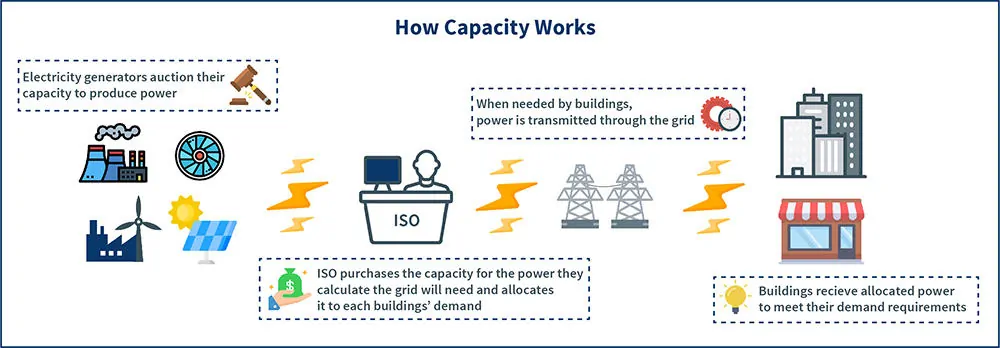Capacity (AKA electricity demand) is often the second largest component of an electricity price.
Most have heard of capacity or electricity demand, but don’t understand exactly what it is. This is because it’s a pretty confusing concept with a lot of nuances to it. Commonly, this price component is the reason many businesses pay so much on their electricity bills! Fortunately, capacity can be strategically managed down to reduce the price you pay for it!
So, what exactly is capacity or electricity demand? Have no fear, Mike Morin is here!
Watch our webinar below, ‘What is Capacity?’ presented by Mike Morin, Best Practice Energy’s VP of Sales & Client Strategy. In this webinar, Mike dives into the capacity piece of the electricity bill puzzle and dilutes it down in a very digestible way. Mike also gives a synopsis on capacity management and how it can reduce your rates.
Essentially, capacity is the amount of electricity a building requires to operate (demand), but not the electricity commodity itself. The ISO calculates the amount of electricity capacity every building on the grid requires to operate fully. They do this so they can purchase and allocate enough electricity for every building to use at any time. This is done to ensure grid reliability. If more power is drawn from the grid than is available, disastrous blackouts can occur.
Check out the chart below for overview of how capacity works:
Electricity Demand and How Capacity Costs are Determined
Capacity costs are a significant portion of an electricity bill. There is a simple equation that determines the price you pay for your building’s capacity: $kWh= CapTag/PLC X Reserves X Price / Your Usage.
Capacity Price
The capacity price is basically the amount of electricity the ISO calculates their grid will need to meet electricity demand. This price is set by auction, which occur every 3 years. Here, the ISO purchases ‘promises’ from generators that they will produce X amount of electricity for the ISO’s grid at specific times.
Reserve Margin
The reserve margin of capacity is an amount of extra electricity that the ISO purchases. The ISO purchases more than they’ll need just in case there are unexpected jumps in electricity demand. Unexpected usage like this can result from unpredicted weather events, powerplants going offline, and a variety of other circumstances.
If these jumps occur, the grid allocates its reserves to handle it. This ensures that the grid always stays reliable. If an unexpected jump in demand did happen and there wasn’t enough electricity to handle it, brownouts or blackouts could occur.
Capacity Tag (CapTag)
Your CapTag (PLC in the PJM area) is set by a snapshot of your usage during peak day(s). These are days during the year when the grid’s load reaches its maximum electricity demand. Peak days usually occur during sustained heatwaves on weekdays during the summer. During these times, the ISO takes a snapshot of your electricity meter to show your usage at the grid’s peak. This is the piece of capacity that can be strategically managed down through capacity management.
Contact us today to learn more about capacity and how capacity management can significantly reduce your electricity bills!
Speaker Information

Michael Morin has served in the energy industry for over 25 years. He has sold or consulted on billions of dollars worth of retail energy transactions in over 50 utilities in the ISO-NE, PJM, and NYISO areas. Mike has an extensive background in retail energy consulting developing procurement strategies. He is also well versed in managing teams that provide highly technical advice to end-users.
Michael began his energy career at Unitil working in various roles focused on managing their 300 MW and 2.5 BCF/yr electric and natural gas portfolios. At the same time, he also served on numerous ISO-NE committees. He then worked in a variety of sales positions with some of the nation’s leading energy supply companies including Constellation, NRG, and NextEra.
As VP of Sales and Client Strategy, Michael is charged with managing the entire sales team at Best Practice Energy. His duties also include crafting energy cost-reduction strategies for our clients and providing technical expertise to facilitate energy strategy execution. He has developed the buying algorithm used by BPE that identifies strategic purchasing opportunities in the energy markets on behalf of our clients.
Michael has degrees in Economics and Mathematics from the University of Maine.

